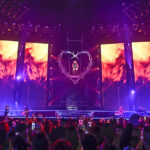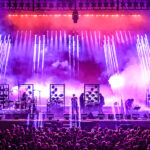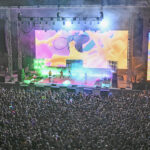Ligting designer and director Dan Hadley first started working with the Foo Fighters when he started filling in for shows here and there in 2001, then eventually took over full duties. Hadley has also worked with the Foo’s Dave Grohl with the band Them Crooked Vultures where Dave plays drums, as well as for Tenacious D where Dave would also fill that seat once in a blue moon.
Hadley’s résumé is quite impressive — Weezer, Pharrell Williams, Jack White, Devo, Sonic Youth and Queens of the Stone Age, to name but a few, and many of the bands managed by Silva Artist Management, where there tends to be some cross-pollination within their roster. Hadley started the design knowing the tour would play arenas, sheds and stadium/ festivals. He’s had to make some adjustments because the arenas sold too well, so he’s had to make concessions for sight lines, which in the bigger picture is a good problem to have.
Dan Hadley, Lighting Designer/Director
“I am the luckiest guy when it comes to the Foo Fighters team, and I am surrounded by many who will argue that they are luckier for the same reasons. Lots of us have been friends, and even neighbors, for a long time. Queens of the Stone Age is another unifying factor in that many of us toured with them (as did Dave for a brief moment at the beginning of the Songs For The Deaf tour cycle). The core crew is all appreciative, and we’re pretty quick to call one another out if anyone gets too fancy or precious. I think that’s why we’re all here, and I also know that the similar disposition that comes from the top keeps us that way. Without a lot of drama to get in the way, it leaves us the time to be able to look around and take note of the audience, who we all know is the reason we’re here.”

For fixtures, the tour is using, on the back of the video wall, 60 Ayrton MagicBlades, 24 Robe Pointes, 18 Clay Paky Sharpy Washes as well as 18 Clay Paky Mythos along the top. Before the video spins around, the fixtures poke through the breaks to hit the band with sidelight and also to make the PAR rig video clips come to life. Up above, and for downstage, sidelight comes from a host of Martin Viper Profiles and Viper AirFX fixtures.
“The Viper Profiles and Viper AirFX are great as the workhorse and I really miss them when we roll into a festival and I have to clone in another fixture. We also have Solaris Flares pulling some heavy double duty as the incredible strobe that they are, and also above the stage to lay a base coat of color and on the downstage truss to light up and color the audience. I tried, but I still couldn’t get away without Mole fays, so we have those as well. Dave likes to see the audience a LOT throughout the night.”
As is quite well known (with all things hitting the Internet), Dave Grohl had a mishap on June 12, falling off the stage and breaking his leg in Gothenburg, Sweden during their performance, but with Grohl’s “the show must go on” attitude, aside from some cancelled dates right after to heal, the band has continued on and made the injury a part of the show, with the “throne” Grohl now sits in part of the show.

“For Dave’s throne, the Ayrton MagicDots were a very easy choice. I needed something that was small but rich with options — SOLD. It was very nice that they matched the MagicBlades in their behavior and such, so I could clone all the palettes over and save some precious time ahead of the throne’s first show in DC. There’s a ZR44 fogger and two Solaris Flares inside the base, and there’s one Flare mounted on the back of the chair. I translated Dave’s napkin drawings into 3D using Vectorworks and sent it off to SGPS (Show Group Production Services). They made some revisions and started building immediately. We also had to give Dave all the options to get out into the audience. No one has ever done a Foo Fighters show with an immobile Grohl, so we wanted to offer him some possibilities, as connecting with the audience is very important to him and to the show. The actual seat part of the throne detaches from the base in order to be lifted by SGPS’ Free Fly system, which would have had him flying out over the audience. We also had one of SGPS’ turret arms sent out. Dave really wanted the throne to go out over the audience, but the weight ended up being a limiting factor. We finally decided that the smoothest way to do it was to have the throne on an SGPS Creeper Deck that would carry it down the thrust and back. Dave makes the call on when to go out and come back. The other options required a lot of choreography, and with the fluid nature and amount of on-the-fly changes that happen in a typical Foos show, the simplest option worked best. I think they had about five days to build the throne, and changes were coming in constantly. It really was quite amazing of SGPS to be able to pull all of it together and get it to DC on time — hats off to that whole team!”
 “Everyone knew that Dave had finished the show in Sweden after breaking his leg, but no one knew how he was going to deal with doing a stadium show three weeks later, and we didn’t want to give anything away. So we had [scenic fabric company] Sew What? make a beautiful FF logo kabuki that would deploy for the changeover and drop at the top of the show and introduce the throne to the world. The kabuki is 40 by 40 feet, and the logo is 30 feet in diameter. Let me say that there is nothing that replaces the look of an actual physical backdrop. It feels goofy, but the first time it unfurled and we saw it hanging there, I got a little chill, and when there’s an audience, you get two great reactions — once when it appears, and again when it disappears. When it does disappear, it goes in grand fashion by way of SGPS’s Kabuki Sniffer. The center 40-by-40 feet gets sucked up to center, and the side legs (which are there to allow us to customize the width of the total downstage drape up to 80 feet) fall to the deck.
“Everyone knew that Dave had finished the show in Sweden after breaking his leg, but no one knew how he was going to deal with doing a stadium show three weeks later, and we didn’t want to give anything away. So we had [scenic fabric company] Sew What? make a beautiful FF logo kabuki that would deploy for the changeover and drop at the top of the show and introduce the throne to the world. The kabuki is 40 by 40 feet, and the logo is 30 feet in diameter. Let me say that there is nothing that replaces the look of an actual physical backdrop. It feels goofy, but the first time it unfurled and we saw it hanging there, I got a little chill, and when there’s an audience, you get two great reactions — once when it appears, and again when it disappears. When it does disappear, it goes in grand fashion by way of SGPS’s Kabuki Sniffer. The center 40-by-40 feet gets sucked up to center, and the side legs (which are there to allow us to customize the width of the total downstage drape up to 80 feet) fall to the deck.
“Once we started in the arenas, we also added perpendicular drapes stage left and stage right to mask the stage from the side seats. These get pulled upstage on SGPS’ single-track truss, which is a much better solution than the drapes dropping between the band and their techs/monitor engineer. Any one who has toured with old style traveler track will know immediately how sexy this system is. The final straw was when I saw the thousands of selfies being taken with it in the background. It sealed the deal, and we’re keeping it in the show, probably even after Dave’s doctors give him the okay to dismount the throne.”
Supplying the video element for the tour is PRG/Nocturne. VER came in for lighting.
“They’ve both been great. Almost all the VER folks involved with us are formerly from Ed & Ted’s Excellent Lighting, with whom I had a great relationship; from their inception, in an odd way.”
 At Hadley’s side out at FOH is video screen programmer Leif Dixon. Hadley calls him his “indispensable sideman.”
At Hadley’s side out at FOH is video screen programmer Leif Dixon. Hadley calls him his “indispensable sideman.”
“Leif mostly takes care of all things that go on the screens but he also keeps me on task and looks out for the things which threaten to derail me, programming or otherwise. I programmed all the lighting and he programmed all the video into the same show file and we run the show in the same session. Some of the video is fired in with my lighting, but most of it is him going along with the band, as things are so prone to change and to manage screens as well as lights would be asking for trouble. We’ve known each other a long time, he’s been lighting director for a couple of my designs and he’s always been one of the first names I recommend when I’m asked for an LD. I’m very lucky that the Chili Peppers didn’t have anything scheduled.
“The programming of the tour was very involved as we have so many possible configurations of the rig and a set list that is always in flux and changes on the fly. For the first few months we had the help of Control Freak Systems’ Andy Babin and the three of us worked very closely to make a sensible system for being able to do any song at any point in the set list, no matter the position of the screens and lighting. This meant that the back wall had to have programming for all the songs, some of which fall in the first part of the set and I haven’t seen since we programmed it. With everything programmed into every song I now make use of group masters to turn off chunks of the rig when I don’t need it, it’s been a real pleasure to go through the simplification process after the initial over-programming.”
The Foos aren’t really a video content sort of band, says Hadley.
“I’m very wary of using video, so this was a tough area. The main reason I put a big screen on stage was because the venues are big and I really needed to get Dave’s face to the back of the room. This is normally taken care of by the I-Mag screens, but I hate seeing the audience with their attention directed to the side while the band is right in front of them. So our basic rule is that we don’t force the audience to make that choice — anything that’s on the I-Mag is also on the upstage screen, with no temptation to turn your attention away from the stage, but with all the utility that I-Mag is great for. We try to only stray from that rule when we use the side screens to stretch the canvas beyond the proscenium to make one very wide scene. And even with that, it’s mostly camera feeds with treatments; there’s not much content, per se.”
 Hadley credits Moment Factory for clips using the album artwork and B-Roll footage from the Sonic Highways HBO series, but he found that having the creativity come from outside didn’t work all that well.
Hadley credits Moment Factory for clips using the album artwork and B-Roll footage from the Sonic Highways HBO series, but he found that having the creativity come from outside didn’t work all that well.
“Leif and I ended up feeding concepts and sources to Robb Wagner at Stimulated TV, and they were great at cultivating those into files that work for us. We used Leif’s camera to film some PAR cans at VER and got some amazing fake rigs that Robb’s team put together, and we use that for when the band does the inevitable ‘cover’ tune. Our video director Josh Adams has even contributed by creating some stills in addition to his awesome live direction. It’s been great working with him a lot more than simply having his skills pushed off to the side screens.
“I have great things to say about all the Foo crew members. Our production manager Joe Beebe is very adamant about not having any screaming hotheads or poisonous personalities on the road, which makes it a very nice environment, and the challenging gigs are seen as our days to shine, not just a chance to bitch and moan.”
Crew
Lighting Designer & Director: Dan Hadley/handadley.com
Lighting Co: VER/Kevin Forster
VER Lighting Crew Chief: Storm Sollars (also Jim Petrusson, Pat Clark)
VER Lighting Techs: Greg Gore, Justin Freeman, Armando Figueroa, Jorge “Soline”’ Velazquez, Pete Nieto
Video Co: PRG Nocturne/John Wiseman
Video Control: Control Freak Systems
Video Director: Josh Adams
Video Screens Programmer: Leif Dixon
Video Crew Chief: Dustin King
Video OP/Utility: Tim Clohessy, Grant Vaught
LED Video/Camera Operators: Adam Finer, Jeff Gainer
LED Video Tech: L Sidney Ptah
Video Engineer: Graham Holwill
LED Side Screens: Joe Bradley
Staging: SGPS Showrig/Eric Pearce
Staging Crew Chiefs: Len Perciful, Alex Dew
Automation: Colin Nevins
Staging Techs: Neil welch Jr., Chris Kunkle, Derek Purciful
Head Carpenter: Tim Smith
Carpenters: Jesse Thayer, Ernest Sustretovas, Drew Purciful (SGPS); Rommel Martinez, Darrel Brazil
Electrician: Matt Dixon
Tour Manager: Gus Brandt
Production Manager: Joe Beebe
Stage Manager: Andrew Pollard
Production Coordinator: Jane Donald
Production Assistant: Grace Kline
CFS Technician: Troy Giddens (System integrated/programmed w/ Andy Babin)
Riggers: Jim Allison, Matt Durham
Kabukis/Soft Goods: Sew What?
Trucking: Upstaging
Gear
2 grandMA2 consoles
39 Martin MAC Viper AirFx
32 Martin MAC Viper Profile
30 Clay Paky Mythos fixtures
36 TMB Solaris Flares
60 Ayrton MagicBlades
12 Ayrton MagicDots
24 Robe Pointes
18 Clay Paky Sharpy Washes
24 4-Lite Blinder
1 PRG Nocturne custom main screen using V9 LED panels (36’x20’)
1 Control Freak Systems video control system w/MBox servers
4 Reel EFX DF-50 hazers
4 Martin Jem ZR-44 foggers
For more 2015 Foo Fighters tour photos by Steve Jennings, go to:
http://www.prolightingspace.com/photo/albums/foo-fighters-gallery-shot-by-steve-jennings


